Kanji 100: Learn the MostUseful Kanji in Japanese
Covers most of the kanji found on the
Japanese Language Proficiency Test Level N5

Clay & Yumi Boutwell Published by Kotoba Books atSmashwords
Copyright 2011-2016 Kotoba,Inc. Discover other ebooks, software, and booksfor learning Japanese at
http://www.thejapanshop.comand http://www.Kotobainc.com This ebook is licensed for your personalenjoyment only. This ebook may not be re-sold or given away toother people. If you would like to share this book with anotherperson, please purchase an additional copy for each person.
KANJI--an Introduction
Kanji make up the third part of the Japanesewriting system after Hiragana and Katakana. Imported from Chinahundreds of years ago, kanji have evolved in a number of ways tomake them sometimes considerably different from their Chineseancestors.
They may look different and sound different. Even still,knowing Japanese kanji often means you can guess the meaning ofwritten Chinese--even if you have never studied Chinese! There are about 2,000 kanji needed to beliterate in Japan. But in reality, knowing just a few hundred willallow you to read most anything. You may need the occasional aid ofa dictionary, however. Very few foreigners have mastered kanji.Could you be one of them? Most kanji have a single main meaning (thiscould be an abstract notion or something more concrete) and two ormore "readings" or pronunciations. The readings are either "onyomi" or "kun yomi." The "on" pronunciation wasthe original Chinese pronunciation--or at least the sounds Japanesepeople thought were the Chinese pronunciation.
The "kun"pronunciation was the native Japanese pronunciation for thatparticular concept. Due to changes in sounds over time, some kanjihave an impressive number of pronunciations. It is best to learnthese sounds by example which is why we include multiple examplewords with each kanji in this ebook. How do I study kanji? You gotta love 'em! If you don't decide from the beginning to lovekanji, I am sure you will end up hating them. There are many, manycharacters with various meanings and readings, so without a desireto explore, you will become quickly discouraged. Write them! Speak them! Look forthem! My suggestions for studying kanji areto
- Create fun mnemonics that will help youremember the character.
Make it personal and even absurd to make itstick better. For example, the moon  looks like the character for sun
looks like the character for sun  but with legs. Think of the moontrying to run away from the sun since it usually only comesout at night. If you can think of a mnemonic for one or morereadings, all the better.
but with legs. Think of the moontrying to run away from the sun since it usually only comesout at night. If you can think of a mnemonic for one or morereadings, all the better.
- Copy each individual kanji several times whilespeaking and thinking on the readings.
- Finally, read! Use the power of a searchengine to look for the newly learned kanji in other contexts.
- Finally, read! Use the power of a searchengine to look for the newly learned kanji in other contexts.
It isan exciting feeling to come across kanji that you have juststudied.
Kanji Stroke Order
There are good reasons to remember thecorrect stroke order from the very beginning:
- By following the set order, kanji willlook more like it should and therefore be easier toread.
- You can remember new kanji better byknowing the order to write them.
- Kanji dictionaries often list kanji bystroke number.
- Kanji is an art form in Japan and theywill know when you cheat!

If you only have time toremember one thing get this: START FROM THE TOP-LEFT OFTHE KANJI AND WORK DOWN TO THE BOTTOM-RIGHT.

(the numberten)

But it wouldn't be funwithout exceptions!

(ricefield)


(king)


RULE #3 : If you have left,right, and center options, work from the center.

(water)


(thread)


RULE #4 : If there is an outsidebit surrounding an inside bit, the outsidecomes first.

(country)


(wind)

Except when the outside isshaped like a "C" (district)


RULE #5 : If there is a vertical line going through otherparts, it comes last or at leastlater.




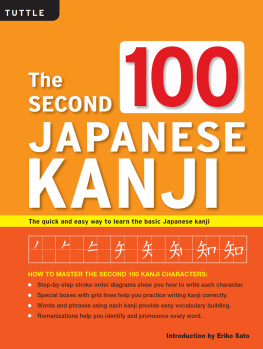
![Eriko Sato - My First Japanese Kanji Book: Learning kanji the fun and easy way! [Downloadable MP3 Audio Included]](/uploads/posts/book/406403/thumbs/eriko-sato-my-first-japanese-kanji-book-learning.jpg)
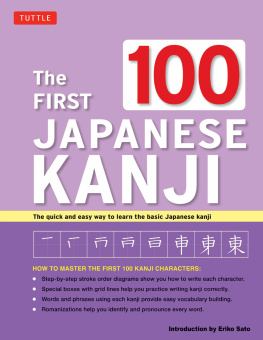


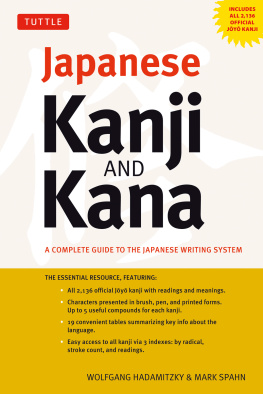

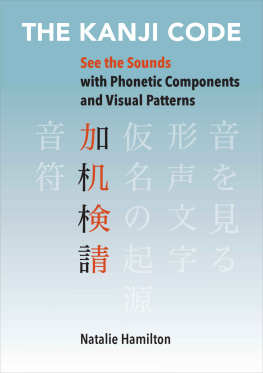
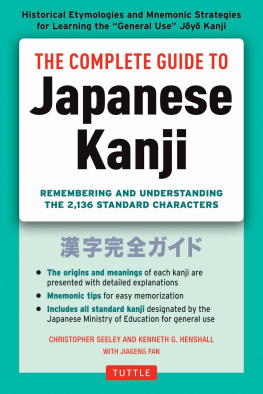
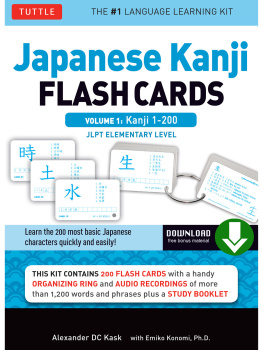

 Clay & Yumi Boutwell Published by Kotoba Books atSmashwords
Clay & Yumi Boutwell Published by Kotoba Books atSmashwords looks like the character for sun
looks like the character for sun  but with legs. Think of the moontrying to run away from the sun since it usually only comesout at night. If you can think of a mnemonic for one or morereadings, all the better.
but with legs. Think of the moontrying to run away from the sun since it usually only comesout at night. If you can think of a mnemonic for one or morereadings, all the better. If you only have time toremember one thing get this: START FROM THE TOP-LEFT OFTHE KANJI AND WORK DOWN TO THE BOTTOM-RIGHT.
If you only have time toremember one thing get this: START FROM THE TOP-LEFT OFTHE KANJI AND WORK DOWN TO THE BOTTOM-RIGHT.  (the numberten)
(the numberten) But it wouldn't be funwithout exceptions!
But it wouldn't be funwithout exceptions!  (ricefield)
(ricefield)
 (king)
(king)
 (water)
(water)
 (thread)
(thread)
 (country)
(country)
 (wind)
(wind) Except when the outside isshaped like a "C" (district)
Except when the outside isshaped like a "C" (district)
